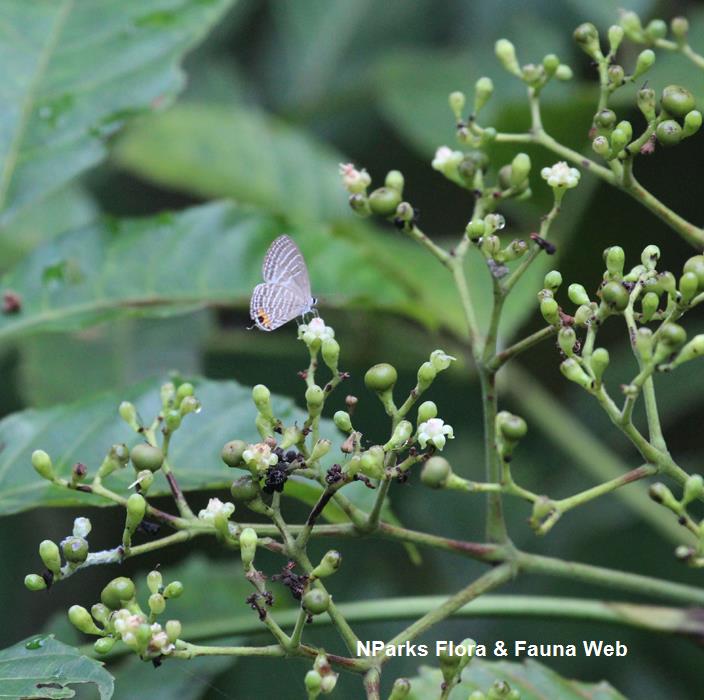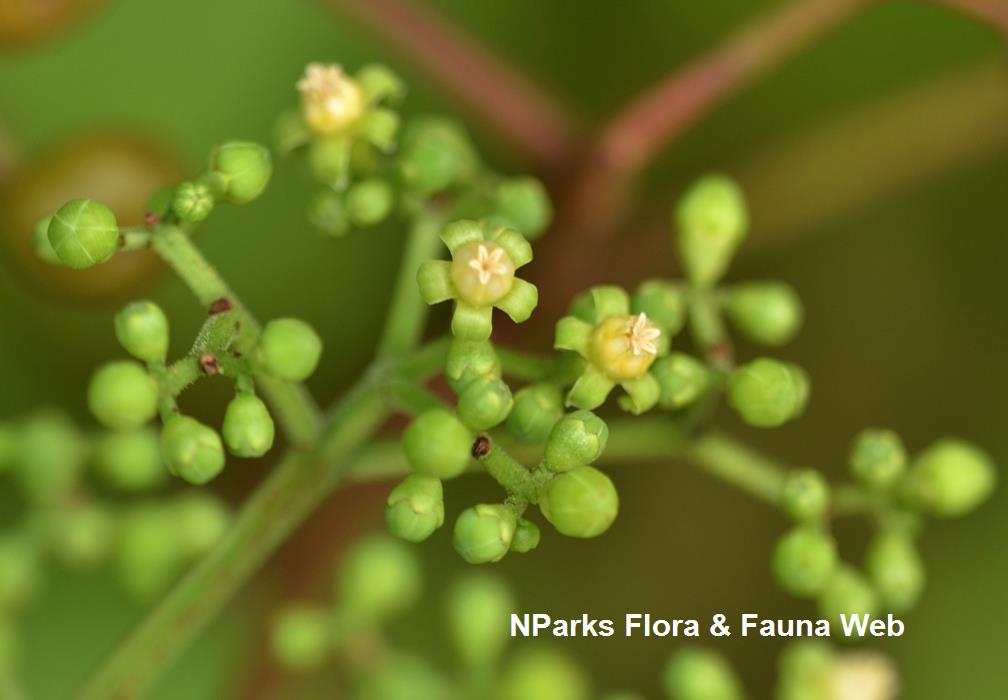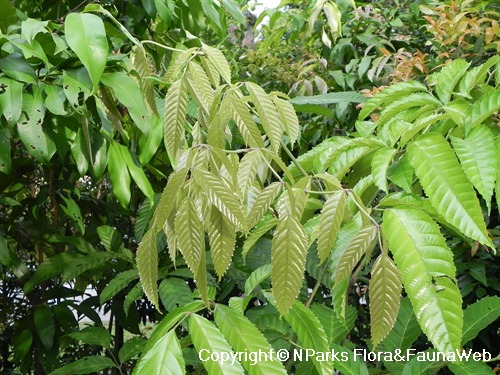
Back
Leea indica (Burm.f.) Merr.
| Family Name: | Vitaceae |
| Synonyms: | Leea gigantea Griff., Leea sambucina Willd., Leea sundaica Miq. |
| Common Name: | Bandicoot Berry, Common Tree-Vine, Jolok-Jolok, Merbati Padang, 火筒树 |
Name
Classifications and Characteristics
| Plant Division | Angiosperms (Flowering Seed Plants) |
|---|---|
| Plant Growth Form | Shrub, Tree (Small (6m-15m)) |
| Lifespan (in Singapore) | Perennial |
| Mode of Nutrition | Autotrophic |
| Plant Shape | Irregular |
| Maximum Height | 15 m |
Biogeography
| Native Distribution | India, Sri Lanka, Nepal, Bangladesh, Andaman and Nicobar Islands, Thailand, Indochina, southern China, through Peninsular Malaysia and Singapore, Sumatra, Borneo, the Philippines, throughout Indonesia to New Guinea, northern Australia, Solomon Islands Vanuatu and Fiji. |
|---|---|
| Native Habitat | Terrestrial (Primary Rainforest, Mountain, Secondary Rainforest, Monsoon Forest, Coastal Forest, Freshwater Swamp Forest, Grassland / Savannah/ Scrubland) |
| Preferred Climate Zone | Tropical |
| Local Conservation Status | Native to Singapore (Least Concern (LC)) |
Description and Ethnobotany
| Growth Form | It is a shrub or small tree up to 15 m tall. |
|---|---|
| Foliage | Its alternate, stalked, twice or thrice pinnate leaves are 45-60 cm long, with many leaflets. |
| Flowers | Its greenish-white flowers are found in a branched flowering shoot. |
| Fruit | Its round fruits are purplish-black when ripe, 5-15 mm wide and contains up to six seeds. |
| Habitat | It grows in wet areas of primary and secondary forests, from sea level up to mountains 2,500 m in altitude. |
| Associated Fauna | Its flowers are pollinated by insects and butterflies. The fruits are eaten by birds, especially bulbuls. |
| Cultivation | It can be propagated by seed or stem cuttings. |
| Etymology | Latin Leea, a name for tropical small trees or shrubs named for James Lee (1715–1795), who was a nurseryman; Latin indica, from India, referring to one of the countries in its natural distribution range. |
| Ethnobotanical Uses | Edible Plant Parts : Edible Fruits, Edible Leaves Medicinal: The leaves are used for treating body pains, cuts, fever, skin complaints, vertigo, and wounds. A decoction of the shoots is used to treat sores. Body pains, fevers and insomnia is believed to be cured by beating the body with the leafy shoots. The roots are viewed to be antipyretic and diaphoretic, and are used to relieve colic, diarrhoea, dysentery, muscular pain and to induce perspiration. It is also used to treat leucorrhoea, interstinal and uterine cancer. |
Landscaping Features
| Landscaping | It is suitable for growing along streetscapes, parks and gardens. |
|---|---|
| Desirable Plant Features | Ornamental Foliage, Ornamental Form |
| Landscape Uses | General, Suitable for Roadsides, Parks & Gardens, Small Gardens, Hedge / Screening |
Fauna, Pollination and Dispersal
| Fauna Pollination Dispersal Associated Fauna | Bird-Attracting (Fruits), Butterfly-Attracting (Flower Nectar), Bee-Attracting |
|---|---|
| Pollination Method(s) | Biotic (Fauna) (Insects (Butterfly, Moth), Insects (Bee)) |
| Seed or Spore Dispersal | Biotic (Fauna) (Vertebrates (Other Mammal)) |
Plant Care and Propagation
| Light Preference | Semi-Shade, Full Sun |
|---|---|
| Water Preference | Moderate Water |
| Plant Growth Rate | Moderate |
| Rootzone Tolerance | Moist Soils, Well-Drained Soils, Saline Soils / Salt Spray, Fertile Loamy Soils, Easy to Grow |
| Transplanting Tolerance | Good |
| Maintenance Requirements | Moderate |
| Propagation Method | Seed, Stem Cutting |
Foliar
| Foliage Retention | Evergreen |
|---|---|
| Mature Foliage Colour(s) | Green |
| Mature Foliage Texture(s) | Leathery |
| Foliar Type | Compound |
| Foliar Arrangement Along Stem | Alternate |
| Foliar Attachment to Stem | Petiolate |
| Foliar Shape(s) | Non-Palm Foliage |
| Foliar Venation | Pinnate / Net |
| Foliar Margin | Serrate / Toothed |
| Leaf Area Index (LAI) for Green Plot Ratio | 4.5 (Shrub & Groundcover - Dicot) |
Floral (Angiosperm)
| Flower & Plant Sexuality | Bisexual Flowers |
| Flower Colour(s) | Green, Yellow / Golden |
|---|---|
| Flower Grouping | Cluster / Inflorescence |
| Flower Location | Terminal |
| Flower Symmetry | Radial |
Fruit, Seed and Spore
| Mature Fruit Colour(s) | Black |
|---|---|
| Fruit Classification | Simple Fruit |
| Fruit Type | Fleshy Fruit , Non-Accessory Fruit |
Image Repository
Others
| Master ID | 897 |
|---|---|
| Species ID | 2191 |
| Flora Disclaimer | The information in this website has been compiled from reliable sources, such as reference works on medicinal plants. It is not a substitute for medical advice or treatment and NParks does not purport to provide any medical advice. Readers should always consult his/her physician before using or consuming a plant for medicinal purposes. |












